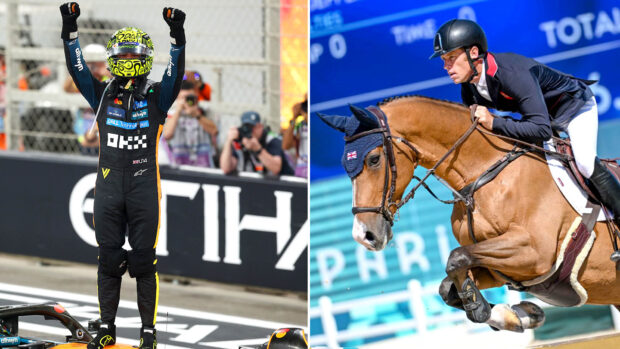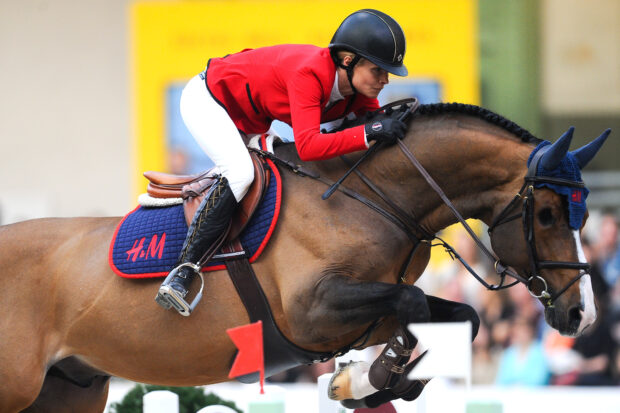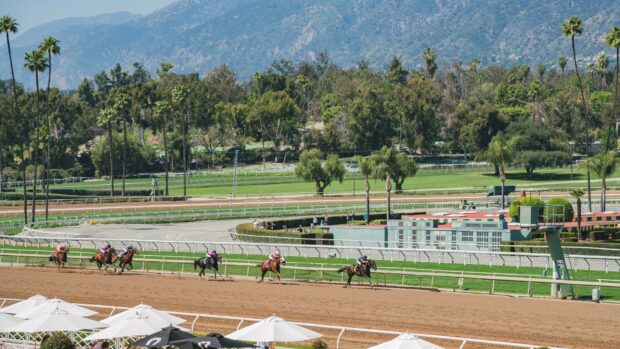The trainer
Former Burghley winner Gill Watson is one of the world’s most successful eventing trainers and has led the British junior and young rider teams to more than 60 European team and individual medals.
The guinea-pigs
Dee, a four-year-old gelding, is by a Thoroughbred stallion out of a mare who completed Windsor three-day event. Backed last year this was the first time he had jumped outdoors. His rider, 17-year-old Emily Jarvis, has competed in junior events and hopes to make a career in the sport.
Dee has not yet learned to balance himself in canter carrying the weight of a rider. As he has yet to develop strength, he tends to fall back into trot or go long and flat. This is not abnormal as he is still growing, but an older horse could have the same problem due to lack of muscle.This grid exercise will help Dee maintain canter and give Emily a feel for the correct rhythm and balance.
We start by trotting into a grid, then build up via bounces to cantering two jumps four strides apart. Working over a pole – sometimes a raised one – helps the horse to lift naturally into the canter transition, while making the initial take-off from trot helps to strengthen his quarters and transfer his weight to the hind legs in order to lift the front end. The bounce strides help him to keep the “lift” which maintains the canter.It is important to work on both reins, but begin with the rein on which the horse is happiest when cantering. Whennot jumping, keep him moving forward in a rhythmical trot.
- Having warmed Dee up, we start with a small cross-pole with a placing pole 9ft in front. The first time, it takes Dee by surprise, he gets confused over the placing pole and stops, mainly because he is not concentrating and moving forward in front of the leg.
On the second attempt, he makes the stride and takes a huge leap over the fence. Giving it some height is fine, as it means he is picking up in front, but if hegives it too much he could scare himself, so make sure he is confident over it before increasing the grid. - When he is happy trotting in and cantering away, we add a slightly raised pole 20ft after the jump. This turns out to be too long, so we move it 1ft in – I cannot stress too much how vital it is to adapt the distances and progression of this exercise to suit the individual horse.
Now, with one clear stride on landing, Dee has time to think – crowding him could cause him to panic and rush – and having to “lift” over the pole helps him maintain the canter.
Once he has mastered this, we add another raised pole 12ft from the first, making a bounce to help him even more. - Gradually, when he is confident, we add a third bounce pole, then a final jump, so we have done plenty to help Dee keep the bouncy canter. It is noticeable at this stage that he starts to keep the canter much more easily after the grid, as he shortens his stride and his balance improves. Onthe circle, his trot has become more supple and balanced and he is much less on the forehand than before.
- Dee is starting to find the canter transition on the flat easier, so we try approaching in canter without the placing pole. He comes in fast and flat, so cannot establish a round canter.
Emily needs to ride the stride forward from leg to rein, trying to keep a rhythm and not allow each stride to get longer than the last. You may find this is easier to achieve on a circle.
Her instinct is to compensate by tightening her leg and loosening the rein, directing all his energy on to the forehand. However, if she lightens her leg, the communication between leg and hand will improve. The leg should not grip, but should be therewhen needed, and the rider’s balance is vital. Once a horse starts to develop the right muscles, he will find this much easier. - We go back to a placing pole and approach in trot again. The problems Dee had last time caused him to tap the poles. Although, in his case, he learned from the experience and was more careful this time, do watch out in case your horse loses confidence at any stage. If he does, simplify the exercise.
Then we change the shape of the final element to make him take a fresh look. Alternatively, you could add a filler, but do not raise the fence too soon. - Once Dee is going well through the grid, we take out the bounce poles, leaving two fences four strides apart.
If Emily lets him get too long and flat he tries to make it in three strides, causing him to take off too early at the second fence, which can be dangerous, and Emily gets left behind the movement.
It is important to sit up, with your weight down through your leg on to your foot and shoulders always in front of hips – then your body can be in the correct position while keeping your seat light.
Once Emily has the courage to maintain the canter we achieve our objective of approaching in canter and taking four canterstrides between the fences without gaining ground, which sets Dee up for the second element. - Gill Watson’s book A Young Person’s Guide to Eventing is published by the Pony Club, price £13.95 (£10 to members).
An overview – tips for approaching this exercise
The rider needs to focus ahead and take an overall view of the whole exercise, from approach to getaway. Be aware of the stillness of your body and the security of your lower leg without creating tension, which affects the horse.
There is a fine balance between being positive but not being tense or interfering too much. Do not chase the horse out of balance or rely on speed to get you over the jumps.
A quiet hand is also important, as it is your bodyweight and the direction in which you look that steers the horse, and you must not stop him thinking for himself.
The rider must have the whole task in mind, but remember it is the horse which actually looks at the fence once you have presented him at it – hence the importance of a good approach – by which time you should be looking up and forward.


